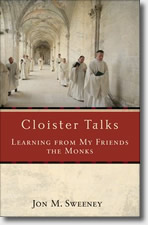What is the Rule of St. Benedict,
and Why Would it Interest Me?
 Perhaps you’ve heard of it, or him.
Perhaps you’ve heard of it, or him.
Meet St. Benedict of Nursia. A simple Italian monk of the sixth century. More than 1500 years ago he composed his now famous Rule for monastic life. There were monks here and there before Benedict, but it was he who crystallized the best of the fledgling monastic tradition, prescribing a standard of spiritual wisdom that has endured ever since. Historians are still trying to understand why and how his impact was so deep and wide; within a few decades of Benedict’s death there was a house of monks in nearly every medium-size town in Italy. Their monasteries came to dominate the religious landscape of Europe, and they educated the majority of Europe’s political, civic, and religious leaders for centuries. Some people have claimed that the Benedictines were the educators of Europe in the Middle Ages—and that’s no exaggeration.
The Rule of St. Benedict is still the most foundational piece of monastic spirituality in the Western world. The Rule (as it is usually called) is about community living—a day-to-day basic guide originally written for Christian men who wanted to be monks, telling them what to do, how to be Christ-followers in that unique way, and how to get along with each other. Today, people who are committed to monastic values of all kinds turn to the Rule—both lay people and members of vowed religious orders, Catholics as well as Protestants.
The Rule of St. Benedict is not only the basic guide for living for monks of various orders (Benedictine, Cistercian, et cetera), but is also the inspiration for today’s neo-monastic movements in cities around the world. It establishes a way of life rooted in the Gospel and grounded in the scriptural principles of charity, humility, stability, and faithfulness. The Rule sets forth an outline for Christian discipleship drawn from the heart of Jesus’ ministry—the call to follow Christ, to be transformed by the work of the Holy Spirit, and to become living witnesses to the grace of God in the world. Every aspect of Benedictine spirituality flow from it.
Here are just a few spiritual practices that draw their wisdom from Benedict:
DISCIPLINE
“Arise without
delay,” Benedict writes in the Prologue to his Rule. “Let us open our eyes to the
Divine light and attentively hear the Divine voice, calling and exhorting us
daily.”
HUMILITY
A monk is to be
humble, and in his humility, he finds joy and even humor. As Benedict says, “by
means of his very body [he] always shows his humility to all who see him: that
is, in work, in the monastery, in the garden, on the road, in the field, or
wherever he may be … with head always bent down and eyes fixed on the earth, he
always thinks of the guilt of his sins and imagines himself already present
before the terrible judgment seat of God.”
This may not seem like much to laugh
at, or to find joy in, but it can be. Personal humility combined with God’s
judgment can seem at times like preparing for a typhoon by purchasing an
umbrella. There’s not much to do but laugh.
WORK
Before Benedict in the sixth century, work was done by people
who had no choice but to do it. In the Roman
Empire, slaves were acquired to do as much of the physical work as
possible, and getting one’s hands dirty with manual labor was seen as a curse
one was born into. But with Benedict, work became prayer, not to be
distinguished from other kinds of mental prayer. Your hands are praying while
building a table. Your body is praying not only in kneeling before the altar but
in sweating in the fields to produce daily bread. Work was made holy
by St. Benedict.
TOOLS IN THE
SPIRITUAL WORKSHOP
The fourth chapter in the Rule of St. Benedict is my favorite. In it, Benedict prioritizes the good
works of a monk and how to do them—in other words, what tools to use to
accomplish the tasks. Many of the good works he lists are of the obvious
sort—following the ten commandments, for example. But there are some surprises. Monks are
asked, for instance, to “bury the dead” and “to dread hell,” both of which have
much to do with the medieval mindset. But there are others that uniquely aim a
monk at virtue. For example, “not to cherish an opportunity for displaying one’s
anger” and “not to give the kiss of peace insincerely.” A few of the injunctions
reflect values that are still kept in monasteries, but in very few other places:
“to revere the elders,” “to pray for one’s enemies in the love of Christ,” and
“after a quarrel to make peace with the other before sunset.”
Benedict’s language emphasizes the unity of the human person in a way that
was once commonly understood—that is, when a person was believed to respond to God with
body/soul (without distinction) all at once. Benedict reminds the monks: “to
fall often to prayer,” as in, literally, to one’s knees.
PLENTY
MORE
Numerous other
spiritual principles have their origins in Benedict’s great Rule. Hospitality,
for instance, was practiced more in the medieval monasteries than anywhere else
at that time. There were times and places when and where the only safe place
where a man could find refuge—and be treated kindly as a welcome stranger—was in
the monasteries.
And then there is spiritual reading, or lectio divina. Visit almost any Benedictine monastery at meal time and you’ll be treated to a form of this ancient tradition practiced out loud, when a designated monk reads while the others eat. In the refectory the reading is done by one of the brothers, while everyone else eats in silence. The Rule puts it this way: “There is to be complete silence, so that no whisper nor any voice other than that of the reader be heard there. Whatever is wanted for eating and drinking the brethren should pass to one another, so that no one need ask for anything. If, however, something is wanted, it should be asked for by some sign or sound rather than by speaking.” Sometimes this takes place throughout the meal, other times only for part of the time. The books are usually selected by the abbot, and they are not necessarily spiritual. I once spent two lunches at a priory in Vermont listening to a new history of the Civil War.
NOW IT’S YOUR TURN
You may want to consider writing your own Rule of Life,
incorporating the best of the Rule of St. Benedict as well as other
considerations that reflect what’s most important to you in your spiritual
life. Consider:
- What are you living for?
- What is most important in life?
- How do you want to spend your time?
- What does God want for you in terms of worship, study, service, devotion?
A personal Rule of Life is an intentional path of real, concrete steps, taken for the purpose of forming one’s life around an ideal. The word rule, in this case, comes the Latin word regula, which is also the root for words such as ruler, or regular—in other words, those things that are supposed to be models for behavior. If a Rule sounds strict, it’s not supposed to, but if it sounds disciplined, then you’re hearing it correctly. Helpful Rules of Life are patterns that guide us to become people ready for heaven. Popular author Dallas Willard once compared a spiritual Rule to a “Curriculum in Christlikeness”—and that’s just about right.
Copyright © 2009 Jon Sweeney.
